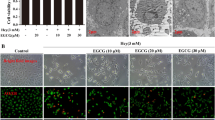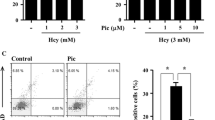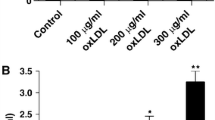Abstract
Hyperhomocysteinemia is an independent risk factor for cardiovascular diseases, although the mechanism leading to vascular dysfunction is not clear. The aim of this study was to examine the effect of homocysteine (Hcy) on oxidative stress and apoptosis in human umbilical vein endothelial cells (HUVECs). HUVECs were challenged for 24 h with Hcy (10 μM-3 mM) in the presence of various stress signaling inhibitors, including the nicotinamide adenine dinucleotide phosphate (NADPH) oxidase inhibitor apocynin (100 μM), the p38 mitogen-activated protein kinase inhibitor SB203580 (2.5 μM), the extracellular signal-regulated kinase inhibitor U0126 (2.5 μM), the stress-activated protein kinase (SAPK)/c-Jun NH2-terminal kinase (JNK) inhibitor JNK inhibitor II (10 μM), and antioxidants α-tocopherol (5 μg/mL) and N-acetyl cysteine (NAC, 2 mM). Reactive oxygen species (ROS) were detected using 5-(6)-chloromethyl-2′,7′-dichlorodihydrofluorescein diacetate. Apoptosis was evaluated by 4′,6′-diamidino-2′-phenylindoladihydrochloride staining, annexin-V phosphatidyl-serine/propidium iodide, and caspase-3 assay. NADPH oxidase and SAPK/JNK signal were evaluated with immunoblotting. Hcy significantly enhanced ROS generation and apoptosis after 24-h incubation. Apocynin prevented Hcy-induced ROS generation but only partially restored Hcy-induced apoptosis. JNK inhibitor II, α-tocopherol, and NAC partially reduced Hcy-induced apoptosis, although SB203580 and U0126 had no effect. Immunoblotting analysis confirmed upregulation of NADPH oxidase and SAPK/JNK signaling. Collectively, our results suggested that Hcy may induce oxidative stress and apoptosis through an NADPH oxidase and/or JNK-dependent mechanisms(s).
Similar content being viewed by others
References
Domagala, T.B., Undas, A., Libura, M., and Szczeklik, A. (1998). Pathogenesis of vascular disease in hyperhomocysteinaemia. J. Cardiovasc. Risk 5:239–247.
Fallon, U.B., Ben-Shlomo, Y., Elwood, P., Ubbink, J.B., and Smith, G.D. (2001). Homocysteine and coronary heart disease in the Caerphilly cohort: a 10 year follow up. Heart 85:153–158.
Mujumdar, V.S., Aru, G.M., and Tyagi, S.C. (2001) Induction of oxidative stress by homocyst(e)ine impairs endothelial function. J. Cell. Biochem. 82:491–500.
Li, N., Yi, F.X., Rute, E., Zhang, D.X., Slocum, G.R., and Zou, A.P. (2002). Effects of homocysteine on intracellular nitric oxide and superoxide levels in the renal arterial endothelium. Am. J. Physiol. Heart Circ. Physiol. 283:H1237-H1243.
Weiss, N., Keller, C., Hoffmann, U., and Loscalzo, J. (2002). Endothelial dysfunction and atherothrombosis in mild hyperhomocysteinemia. Vasc. Med. 7:227–239.
Jacobsen, D.W. (1998). Homocysteine and vitamins in cardiovascular disease. Clin. Chem. 44:1833–1843.
Majors, A., Ehrhart, L.A., and Pezacka, E.H. (1997). Homocysteine as a risk factor for vascular disease: enhanced collagen production and accumulation by smooth muscle cells. Arterioscler. Thromb Vasc. Biol. 17:2074–2081.
Nygard, O., Vollset, S.E., Refsum, H., Brattstrom, L., and Ueland, P.M. (1999). Total homocysteine and cardiovascular disease. J. Intern. Med. 246:425–454.
Privratsky, J.R., Wold, L.E., Sowers, J.R., Quinn, M.T., and Ren, J. (2003). AT1 blockade prevents glucose-induced cardiac dysfunction in ventricular myocytes: role of the AT1 receptor and NADPH oxidate. Hypertension 42:206–212.
Fuentes, L., Perez, R., Nieto, M.L., Balsinde, J., and Balboa, M.A. (2003). Bromoenol lactone promotes cell death by a mechanism involving phosphatidate phosphohydrolase-1 rather than calcium-independent phospholipase A2. J. Biol. Chem. 278:44683–44690.
Jamali, R., Bao, M., and Arnqvist, H.J. (2003). IGF-I but not insulin inhibits apoptosis at a low concentratin in vascular smooth muscle cells. J. Endocrinol. 179:267–274.
Wang, X., Martindale, J.L., and Holbrook, N.J. (2000). Requirement for ERK activation in cisplatin-induced apoptosis. J. Biol. Chem. 275:39435–39443.
Shi, X., and Nuttall, A.L. (2003): Upregulated iNOS and oxidative damage to the cochlear stria vascularis due to noise stress. Brain Res. 967:1–10.
Yuan, Q, Ray, R.M., and Johnson, L.R. (2002). Polyamine depletion prevents camptothecin-induced apoptosis by inhibiting the release of cytochrome c. Am. J. Physiol. Cell Physiol. 282:C1290-C1297.
Bradford, M.M. (1976) A rapid and sensitive method for the quantitation of microgram quantities of protein utilizing the principle of protein-dye binding. Anal. Biochem. 72:248–254.
Zhang, X., Klein, A.L., Alberle, N.S. II, Norby, F.L., Ren, B.H., Duan, J., et al. Cardiac-specific overexpression of catalase rescues ventricular myocytes from ethanol-induced cardiac contractile defect. J. Mol. Cell. Cardiol. 35:645–652.
Huang, R.F., Huang, S.M., Lin, B.S., Wei, J.S., and Liu, T.Z. (2001). Homocysteine thiolactone induces apoptotic DNA damage mediated by increased intracellular hydrogen peroxide and caspase 3 activation in HL-60 cells. Life Sci. 68:2799–2811.
Rodrigo, R., Passalacqua, W., Araya, J., Orellana, M., and Rivera, G. (2003). Implications of oxidative stress and homocysteine in the pathophysiology of essential hypertension. J. Cardiovasc. Pharmacol. 42:453–461.
Zhu, B.T. (2002). On the mechanism of homocysteine pathophysiology and pathogenesis: a unifying hypothesis. Histol. Histopathol. 17:1283–1291.
Assanelli, D., Bonanome, A., Pezzini, A., Albertini, F., Maccalli, P., Grassi, M., et al. (2004). Folic acid and Vitamin E supplementation effects on homocysteinemia, endothelial function and plasma antioxidant capacity in young myocardial-infarction patients. Pharmacol. Res. 49:79–84.
Eikelboom, J.W., Lonn, E., Genest, J. Jr., Hankey, G., and Yusuf, S. (1999). Homocyst(e) ine and cardiovascular disease: a critical review of the epideniologic evidence. Ann. Intern. Med. 131:363–375.
Ford, E.S., Smith, S.J., Stroup, D.F., Steinberg, K.K., Mueller, P.M., and Thacker, S.B. (2002). Homocyst(e) ine and cardiovascular disease: a systematic review of the evidence with special emphasis on case-control studies and nested case-control studies. Int. J. Epidemiol. 31:59–70.
Cai, H., Griendling, K.K., and Harrison, D.G. (2003). The vascular NAD(P)H oxidases as therapeutic targets in cardiovascular diseases. Trends Pharmacol. Sci. 24:471–478.
Martindale, J.L., and Holbrook, N.J. (2002). Cellular response to oxidative stress: signaling for suicide and survival. J. Cell. Physiol. 192:1–15.
Torres, M., and Forman, H.J. (2003). Redox signaling and the MAP kinase pathways. Biofactors 17:287–296.
Cai, Y., Zhang, C., Nawa, T., Aso, T., Tanaka, M., Oshiro, S., et al. (2000). Homocysteine-responsive ATF3 gene expression in human vascular endothelial cells: activation of c-Jun NH(2)-terminal kinase and promoter response element. Blood 96:2140–2148.
Zhang, C., Kawauchi, J., Adachi, M.T., Hashimoto, Y., Oshiro, S., Aso, T., et al. (2001). Activation of JNK and transcriptional repressor ATF3/LRF1 through the IRE1/TRAF2 pathway is implicated in human vascular endothelial cell death by homocysteine. Biochem. Biophys. Res. Commun. 289:718–724.
Benhar, M., Engelberg, D., and Levitzki, A. (2002). ROS, stress-activated kinases and stress signaling in cancer. EMBO Rep. 3:420–425.
Kuranaga, E., and Miura, M. (2002). Molecular genetic control of caspases and JNK-mediated neural cell death. Arch. Histol. Cytol. 65:291–300.
Kyriakis, J.M., and Avruch, J. (2001). Mammalian mitogen-activated protein kinase signal transduction pathways activated by stress and inflammation. Physiol. Rev. 81: 807–869.
Lin, A., and Dibling, B. (2002). The true face of JNK activation in apoptosis. Aging Cell 1:112–116.
Luo, J., Sun, Y., Lin, H., Qian, Y., Li, Z., Leonard, S.S., et al. (2003). Activation of JNK by vanadate induces a Fas-associated death domain (FADD)-dependent death of cerebellar granule progenitors in vitro. J. Biol. Chem. 278: 4542–4551.
Lin, A. (2003). Activation of the JNK signaling pathway: breaking the brake on apoptosis. Bioessays 25:17–24.
Crott, J., and Fenech, M. (2001). Preliminary study of the genotoxic potential of homocysteine in human lymphocytes in vitro. Mutagenesis 16:213–217.
Author information
Authors and Affiliations
Corresponding author
Additional information
The first two authors contributed equally to this work.
Rights and permissions
About this article
Cite this article
Dong, F., Zhang, X., Li, SY. et al. Possible involvement of NADPH oxidase and JNK in homocysteine-induced oxidative stress and apoptosis in human umbilical vein endothelial cells. Cardiovasc Toxicol 5, 9–20 (2005). https://doi.org/10.1385/CT:5:1:009
Received:
Revised:
Accepted:
Issue Date:
DOI: https://doi.org/10.1385/CT:5:1:009




